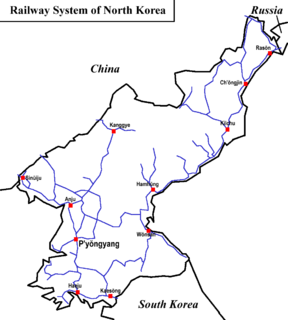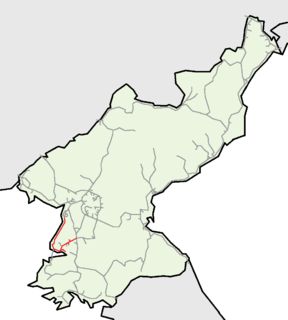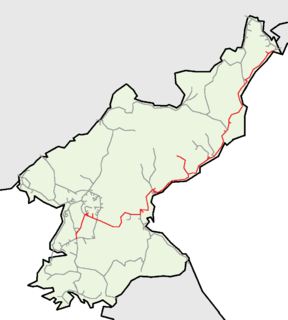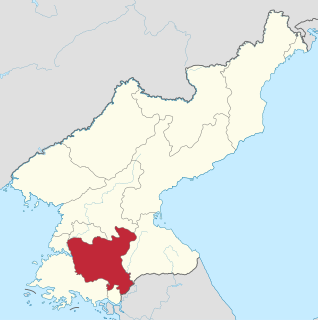
The P'yŏngŭi Line is an electrified main trunk line of the Korean State Railway of North Korea, running from P'yŏngyang to Sinŭiju on the border with China. It is the main corridor for overland traffic between North Korea and China, and is one of the country's most important rail lines. A bridge over the Yalu River connects Sinŭiju to the Chinese city of Dandong and the Shendan Line of the China Railway to Shenyang and Chinese points beyond.

Rail transport in North Korea is provided by Korean State Railway which is the only rail operator in North Korea. It has a network of over 6,000 km of track, of which the vast majority is standard gauge; there is, however, nearly 400 km of narrow-gauge lines (762 mm) in various locations around the country.
Kaesŏng Station is a railway station located in Kaesŏng, North Hwanghae province, North Korea. It is on located on the P'yŏngbu Line, which was formed from part of the Kyŏngŭi Line to accommodate the shift of the capital from Seoul to P'yŏngyang; though this line physically connects P'yŏngyang to Pusan via Dorasan, in operational reality trains terminate here due to the Korean Demilitarized Zone.
Kaep'ung Station is a railway station located in Kaep'ung-ŭp, Kaep'ung County, North Hwanghae province, North Korea. It is on located on the P'yŏngbu Line, which was formed from part of the Kyŏngŭi Line to accommodate the shift of the capital from Seoul to P'yŏngyang; though this line physically connects P'yŏngyang to Pusan via Dorasan, in operational reality it ends at Kaesŏng due to the Korean Demilitarized Zone.
P'yŏngsan Station is a railway station located in P'yŏngsan-ŭp P'yŏngsan County, North Hwanghae province, North Korea. It serves as the junction point of two railway lines - the P'yŏngbu Line, which connects P'yŏngyang to Kaesŏng and the Ch'ŏngnyŏn Ich'ŏn Line, which runs from P'yŏngsan to Sep'ŏ where it connects to the Kangwŏn Line.
Ch'ŏnggye Station is a railway station located in Pongsan County, North Hwanghae province, North Korea. It is on located on the P'yŏngbu Line, which was formed from part of the Kyŏngŭi Line to accommodate the shift of the capital from Seoul to P'yŏngyang; though this line physically connects P'yŏngyang to Pusan via Dorasan, in operational reality it ends at Kaesŏng due to the Korean Demilitarized Zone.
Sariwŏn Ch'ŏngnyŏn Station is the central railway station of Sariwŏn, North Hwanghae province, North Korea. It is on located on the P'yŏngbu Line, which was formed from part of the Kyŏngŭi Line to accommodate the shift of the capital from Seoul to P'yŏngyang; though this line physically connects P'yŏngyang to Pusan via Dorasan, in operational reality it ends at Kaesŏng due to the Korean Demilitarized Zone. It is also the northern terminus of the Hwanghae Ch'ŏngnyŏn Line.

Pyongyang Station is the central railway station of P'yŏngyang, North Korea. It is located in Yŏkchŏn-dong, Chung-guyŏk.

The Korean State Railway is the operating arm of the Ministry of Railways of the Democratic People's Republic of Korea and has its headquarters at P'yŏngyang. The current Minister of Railways is Jang Hyuk, who has held the position since 2015.

The P'yŏngbu Line is an electrified standard-gauge trunk line of the Korean State Railway running from P'yŏngyang to Kaesŏng in North Korea and further south across the DMZ to Seoul in South Korea; the name comes from the two (theoretical) termini of the line: P'yŏngyang and Pusan.

The P'yŏngnam Line is an electrified standard-gauge trunk line of the Korean State Railway in North Korea, linking P'yŏngyang with the port city of Namp'o and the hot springs at P'yŏngnam Onch'ŏn. The length of the line is 89.9 km (55.9 mi).
Ch'ŏngjin Ch'ŏngnyŏn Station is the central railway station in Ch'ŏngjin-si, North Hamgyŏng Province, North Korea. It is the junction point of the Hambuk Line and the P'yŏngra Line of the Korean State Railway, and is the beginning of the Ch'ŏngjinhang Line to Ch'ŏngjin Port.

The P'yŏngbuk Line is an electrified standard-gauge secondary trunk line of the Korean State Railway in North Pyŏngan Province, North Korea, running from Chŏngju on the P'yŏngŭi Line to Ch'ŏngsu; it meets the Ch'ŏngnyŏn P'arwŏn Line at Kusŏng, and at Ch'ŏngsu, via a bridge across the Yalu River, it goes to Shanghekou, China, where it connects to China Railway's Fengshang Railway to Fenghuangcheng.

The P'yŏngdŏk Line is an electrified standard-gauge trunk line of the Korean State Railway in North Korea running from Taedonggang Station in P'yŏngyang, where it connects to the P'yŏngbu, P'yŏngnam, P'yŏngra and P'yŏngŭi Lines, to Kujang, where it connects to the Manp'o and Ch'ŏngnyŏn P'arwŏn Lines. The total length of the line is 192.3 km (119.5 mi).

The P'yŏngra Line is an electrified standard-gauge trunk line of the Korean State Railway in North Korea, running from P'yŏngyang to Rajin, where it connects with the Hambuk Line. It is North Korea's main northeast-southwest rail line.
Hyesan Ch'ŏngnyŏn Station is the central railway station of Hyesan city, located in the Ch'un-dong neighbourhood of greater Hyesan city, Ryanggang province, North Korea. A large station with seven tracks, it is the junction point of the Korean State Railway's Paektusan Ch'ŏngnyŏn and Pukpu lines.

Ch'ilgol Station is a railway station in Kallimgil-dong, Man'gyŏngdae-guyŏk, P'yŏngyang, North Korea, on the P'yŏngnam Line of the Korean State Railway.
Namp'o Station is a railway station in Hanggu-guyŏk, Namp'o Special City, North Korea on the P'yŏngnam Line of the Korean State Railway, as well as the starting point of the Tojiri Line. There is an engine house northwest of the station in Munhwa-dong, Hanggu-guyŏk.

Ch'ŏngsu Station is a railway station of the Korean State Railway in Ch'ŏngsu Workers' District, Sakchu County, North P'yŏngan Province, North Korea. It is the northern terminus of the P'yŏngbuk Line of the Korean State Railway. The line continues past the station to a factory at Namsal-li.
Kusŏng Station is a railway station of the Korean State Railway in Yŏkchŏn-dong, Kusŏng city, North P'yŏngan Province, North Korea, on the P'yŏngbuk Line of the Korean State Railway. It is also the western terminus of the Ch'ŏngnyŏn P'arwŏn Line.












